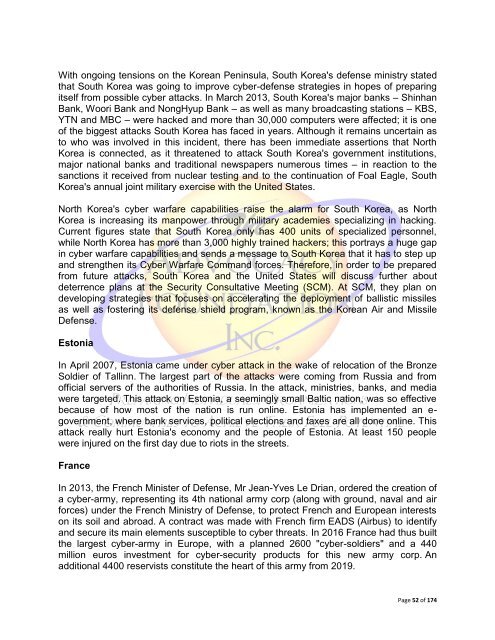International Cyber Terrorism
International Cyber Terrorism
International Cyber Terrorism
- No tags were found...
You also want an ePaper? Increase the reach of your titles
YUMPU automatically turns print PDFs into web optimized ePapers that Google loves.
With ongoing tensions on the Korean Peninsula, South Korea's defense ministry stated<br />
that South Korea was going to improve cyber-defense strategies in hopes of preparing<br />
itself from possible cyber attacks. In March 2013, South Korea's major banks – Shinhan<br />
Bank, Woori Bank and NongHyup Bank – as well as many broadcasting stations – KBS,<br />
YTN and MBC – were hacked and more than 30,000 computers were affected; it is one<br />
of the biggest attacks South Korea has faced in years. Although it remains uncertain as<br />
to who was involved in this incident, there has been immediate assertions that North<br />
Korea is connected, as it threatened to attack South Korea's government institutions,<br />
major national banks and traditional newspapers numerous times – in reaction to the<br />
sanctions it received from nuclear testing and to the continuation of Foal Eagle, South<br />
Korea's annual joint military exercise with the United States.<br />
North Korea's cyber warfare capabilities raise the alarm for South Korea, as North<br />
Korea is increasing its manpower through military academies specializing in hacking.<br />
Current figures state that South Korea only has 400 units of specialized personnel,<br />
while North Korea has more than 3,000 highly trained hackers; this portrays a huge gap<br />
in cyber warfare capabilities and sends a message to South Korea that it has to step up<br />
and strengthen its <strong>Cyber</strong> Warfare Command forces. Therefore, in order to be prepared<br />
from future attacks, South Korea and the United States will discuss further about<br />
deterrence plans at the Security Consultative Meeting (SCM). At SCM, they plan on<br />
developing strategies that focuses on accelerating the deployment of ballistic missiles<br />
as well as fostering its defense shield program, known as the Korean Air and Missile<br />
Defense.<br />
Estonia<br />
In April 2007, Estonia came under cyber attack in the wake of relocation of the Bronze<br />
Soldier of Tallinn. The largest part of the attacks were coming from Russia and from<br />
official servers of the authorities of Russia. In the attack, ministries, banks, and media<br />
were targeted. This attack on Estonia, a seemingly small Baltic nation, was so effective<br />
because of how most of the nation is run online. Estonia has implemented an e-<br />
government, where bank services, political elections and taxes are all done online. This<br />
attack really hurt Estonia's economy and the people of Estonia. At least 150 people<br />
were injured on the first day due to riots in the streets.<br />
France<br />
In 2013, the French Minister of Defense, Mr Jean-Yves Le Drian, ordered the creation of<br />
a cyber-army, representing its 4th national army corp (along with ground, naval and air<br />
forces) under the French Ministry of Defense, to protect French and European interests<br />
on its soil and abroad. A contract was made with French firm EADS (Airbus) to identify<br />
and secure its main elements susceptible to cyber threats. In 2016 France had thus built<br />
the largest cyber-army in Europe, with a planned 2600 "cyber-soldiers" and a 440<br />
million euros investment for cyber-security products for this new army corp. An<br />
additional 4400 reservists constitute the heart of this army from 2019.<br />
Page 52 of 174
















